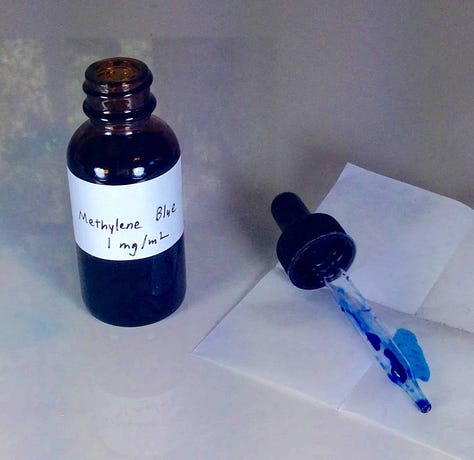The Science and Benefits of Methylene Blue
Unlocking the Potential of a Historical Compound
Methylene blue, an unassuming synthetic compound with a vibrant blue hue, has taken center stage in the scientific exploration of anti-aging and health optimization. Once a staple in medical treatments for conditions such as malaria and urinary tract infections, methylene blue is now being recognized for its potential to enhance mitochondrial function and combat oxidative stress.
This article dives into the history, science, and potential benefits of methylene blue, shedding light on its role in promoting longevity and vitality.



What Is Methylene Blue?
At its core, methylene blue is a synthetic compound originally developed as a dye in the late 1800s. Over time, it found significant applications in medicine, particularly for its antimicrobial properties. Historically, it served as an early antibiotic, effectively treating ailments such as malaria and urinary tract infections before the advent of penicillin.
Today, methylene blue is still used in emergency medicine to treat cyanide or carbon monoxide poisoning. Available in both oral and intravenous forms, the compound is gaining renewed attention for its applications in anti-aging and neuroprotection.



Mitochondria and Aging
The aging process is intricately linked to the decline in mitochondrial function. Mitochondria, the powerhouse of cells, play a critical role in energy production through the electron transport chain. However, as we age, mitochondrial efficiency decreases, leading to oxidative stress and the production of harmful reactive oxygen species (ROS). These processes contribute to cellular damage, DNA mutations, and age-related diseases such as diabetes, cardiovascular conditions, and neurodegeneration.
Methylene blue acts as a redox molecule, meaning it can accept and donate electrons. This property helps stabilize the electron transport chain, enhancing ATP production while reducing oxidative stress. By improving mitochondrial health, methylene blue shows promise in slowing down the physiological decline associated with aging.
Scientific Evidence and Potential Benefits
1. Cognitive Enhancement
Studies suggest that methylene blue may protect against neurodegenerative diseases such as Alzheimer's and Parkinson's. A 2023 review in Cureus highlighted its potential to improve cognitive function, reduce oxidative stress, and mitigate neurodegeneration.
2. Longevity and Vitality
Animal studies have demonstrated that methylene blue supplementation can extend the lifespan of organisms such as worms, flies, and mice. While human studies are still in their infancy, early results indicate its potential to combat age-related decline in humans as well.
3. Skin and Hair Health
Users have reported noticeable improvements in skin elasticity and hair quality, which may be linked to the compound's ability to enhance cellular health and reduce oxidative damage.
4. Enhanced Mood and Focus
Methylene blue’s antidepressant properties stem from its mild influence on serotonin levels. It is even used in psychiatry to treat certain psychiatric conditions. Users have reported improved mental clarity, focus, and mood when using pharmaceutical-grade methylene blue.
Cautions and Contraindications
While methylene blue holds immense promise, it is crucial to use it with caution:
Dosage: Methylene blue is a hormetic drug, meaning its effects vary depending on the dose. Low doses (0.5–2 mg/kg body weight) are therapeutic, while higher doses may be toxic.
Drug Interactions: Combining methylene blue with SSRIs or similar medications can lead to serotonin syndrome, a potentially life-threatening condition.
Specific Conditions: People with G6PD enzyme deficiency or those who are pregnant should avoid methylene blue due to possible adverse effects.
It is worth consulting an expert before starting supplementation, especially when taking other medications.
Practical Considerations
To maximize its benefits, consider the following tips when using methylene blue:
Choose Pharmaceutical-Grade Products: Avoid contaminated versions, such as those intended for industrial use.
Combine with Light Therapy: Red and near-infrared light exposure can amplify its effects, making outdoor activities or specialized light devices valuable additions.
Monitor Long-Term Effects: Since methylene blue is also antimicrobial, prolonged use may disrupt the gut microbiome. Taking breaks from supplementation can help mitigate this risk.



Conclusion
Methylene blue’s ability to enhance mitochondrial function, combat oxidative stress, and protect against neurodegeneration makes it a fascinating candidate in the field of anti-aging. While research is ongoing, its potential to promote longevity and vitality cannot be ignored.
For those exploring methylene blue supplementation, it’s essential to prioritize safety, start with low doses, and consult an expert or do your own research. With careful use, this age-old compound may offer modern solutions to some of the most pressing challenges of aging.
References
Cureus. (2023). "The Role of Methylene Blue in Neurodegeneration and Cognitive Health." (Click here)
Kuehne, J. (2024). "The Science and Benefits of Methylene Blue." [YouTube Transcript]. (Click here)
National Institutes of Health. (2020). "Mitochondrial Function and Aging: Insights into Methylene Blue’s Role." (Click here)



Excellent job of de-mystifying methylene blue, something I had often come across in my readings but never fully understood. Thanks Dr. Trozzi!
I too do not understand it though a friend is a huge user of it and has been to workshops. How on earth to take it without getting blue everywhere? I am old enough to remember gentian violet used for similar purposes.